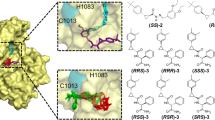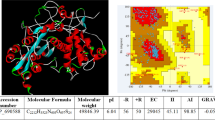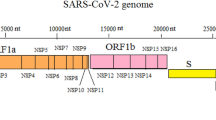Abstract
Chikungunya is one of the most prevailing epidemics all over the world and the viral non-structural protein 2 (nsP2) plays a significant role in pathogenesis associated with this infection. The Chikungunya viral nsP2 induces a transcriptional shut off that suppresses the host cellular antiviral responses. However, the understanding about Chikungunya viral pathogenic proteins is still in its infancy and a specific drug for the disease has not yet been developed. This work attempts to hypothesise the novel drug target peptides associated with Chikungunya viral nsP2, at sequence level. In the present study the Chikungunya viral strains have clustered into five separate groups based on the viral strain lineage. By constructing a global nsP2 sequence from the nsP2 consensus sequences, the conservation variation analysis is performed. These conserved peptides were elicited and tested for its drug target properties. This study strongly suggests the applicability of the derived drug target peptides for the development of effective drugs for the treatment of Chikungunya infection.






Similar content being viewed by others
References
Volk SM, Chen R, Tsetsarkin KA, Paige Adams A, Garcia TI, Sall AA, Nasar F, Schuh AJ, Holmes EC, Higgs S, Maharaj PD, Brault AC, Weaver SC (2010) Genome-scale phylogenetic analyses of chikungunya virus reveal independent emergences of recent epidemics and various evolutionary rates. J Virol 84(13):6497–6504. doi:10.1128/JVI.01603-09
Chhabra M, Mittal V, Bhattacharya D, Rana U, Lal S (2008) Chikungunya fever: a re-emerging viral infection. Indian J Med Microbiol 26(1):5–12
Pongsumpun P (2010) Dynamical transmission model of Chikungunya in Thailand. World Acad Sci Eng Technol 44:1171–1175
Francesca C, Paolo G, Anna MP, Giada R, Maria PL, Vittorio S (2009) Chikungunya: an emerging and spreading arthropod-borne viral disease. J Infect Dev Ctries 3(10):744–752
Sathya PM, Attayur PS, Subhodh KR, Paluru V, Ananganallur NS, Sameer S, Nagarajan M, Itta KC, Dev RG, Anakkathil BS (2010) Outbreak of chikungunya fever, Dakshina Kannada District, South India, 2008. Am J Trop Med Hyg 83(4):751–754
Arvind J, Ashok S, Maniram K, Naveen P, Sachin J (2007) Chikungunya fever. J Indian Acad Clin Med 8(2):164–168
Powers AM, Logue CH (2007) Changing patterns of chikungunya virus: re-emergence of a zoonotic arbovirus. J Gen Virol 88(9):2363–2377
Bouraï M, Lucas-Hourani M, Gad HH, Drosten C, Jacob Y, Tafforeau L, Cassonnet P, Jones LM, Judith D, Couderc T, Lecuit M, André P, Kümmerer BM, Lotteau V, Desprès P, Tangy F, Vidalain PO (2012) Mapping of chikungunya virus interactions with host proteins identified nsP2 as a highly connected viral component. J Virol 86(6):3121–3134
Judith D, Mostowy S, Bourai M, Gangneux N, Lelek M, Lucas-Hourani M, Cayet N, Jacob Y, Prévost MC, Pierre P, Tangy F, Zimmer C, Vidalain PO, Couderc T, Lecuit M (2013) Species-specific impact of the autophagy machinery on chikungunya virus infection. Eur Mol Biol Organ Rep 4(6):534–544
Khan AH, Morita K, Parquet MdMdel C, Hasebe F, Mathenge EG, Igarashi A (2003) Complete nucleotide sequence of chikungunya virus and evidence for an internal polyadenylation site. J Gen Virol 83(12):3075–3084
Fros JJ, Liu WJ, Prow NA, Geertsema C, Ligtenberg M, Vanlandingham DL, Schnettler E, Vlak JM, Suhrbier A, Khromykh AA, Pijlman GP (2010) Chikungunya virus nonstructural protein 2 inhibits type I/II interferon-stimulated JAK-STAT signaling. J Virol 84(20):10877–10887
Singh K, Kirubakaran P, Nagarajan S, Sakkiah S, Muthusamy K, Velmurgan D, Jeyakanthan J (2012) Homology modeling, molecular dynamics, e-pharmacophore mapping and docking study of chikungunya virus nsP2 protease. J Mol Model 18(1):39–51
Krishnan A, Li K-B, Issac P (2004) Rapid detection of conserved regions in protein sequences using wavelets. Silico Biol 4(2):133–148
Fang Z, Du R, Edwards A, Flemington EK, Zhang K (2013) The sequence structures of human microRNA molecules and their implications. PLoS ONE 8(1):e54215. doi:10.1371/journal.pone.0054215
Wang EY, DeLisi C (2006) Inferring protein–protein interactions in viral proteins by co-evolution of conserved side chains. Genome Inform 17(1):23–35
De Groot AS, Jesdale B, Martin W, Saint AC, Sbai H, Bosma A, Lieberman J, Skowron G, Mansourati F, Mayer KH (2003) Mapping cross-clade HIV-1 vaccine epitopes using a bioinformatics approach. Vaccine 21(27–30):4486–4505
Wilson CC, McKinney D, Anders M, MaWhinney S, Forster J, Crimi C, Southwood S, Sette A, Chesnut R, Newman MJ, Livingston BD (2003) Development of a DNA vaccine designed to induce cytotoxic T lymphocyte responses to multiple conserved epitopes in HIV-1. J Immunol 171(10):5611–5623
Xie PW, Xie Y, Zhang XJ, Huang H, He LN, Wang XJ, Wang SQ (2013) Inhibition of Dengue virus 2 replication by artificial microRNAs targeting the conserved regions. Nucleic Acid Ther 23(4):244–252
De DW, Yonghui Z, Qiong Z, Jing K, Wenjia L, Huan Z, Corina M, Qiaoli Z, Wenjie L, Haojie Z, Jianfeng H, Hui L, Songwu C, Changwen K, Jinyan L (2013) Chikungunya virus with E1-A226V mutation causing two outbreaks in 2010, Guangdong, China. Virol J 10:174. doi:10.1186/1743-422X-10-174
Tamura K, Peterson D, Peterson N, Stecher G, Nei M, Kumar S (2011) MEGA5: molecular evolutionary genetics analysis using maximum likelihood, evolutionary distance, and maximum parsimony methods. Mol Biol Evol. doi:10.1093/molbev/msr121
Rice P, Longden I, Bleasby A (2000) EMBOSS: the European molecular biology open software suite. Trends Genet 16(6):276–277
Gasteiger E, Gattiker A, Hoogland C, Ivanyi I, Appel RD, Bairoch A (2003) ExPASy: the proteomics server for in-depth protein knowledge and analysis. Nucleic Acids Res 31(13):3784–3788
Larkin MA, Blackshields G, Brown NP, Chenna R, McGettigan PA, McWilliam H, Valentin F, Wallace IM, Wilm A, Lopez R, Thompson JD, Gibson TJ, Higgins DG (2007) ClustalW and clustalX version 2. Bioinformatics 23(21):2947–2948
Mullan LJ, Bleasby AJ (2002) Short EMBOSS user guide. Eur Mol Biol Open Softw Suite Brief Bioinform 3(1):92–94
Bakheet TM, Doig AJ (2009) Properties and identification of human protein drug targets. Bioinformatics 25(4):451–457
SobiaIdrees UAA, Idrees N (2013) Development of global consensus sequence of HCV glycoproteins involved in viral entry. Theor Biol Med Model 10:24. doi:10.1186/1742-4682-10-24
Qingliang L, Luhua L (2007) Prediction of potential drug targets based on simple sequence properties. BMC Bioinform 8(353). doi:10.1186/1471-2105-8-353
Hopkins AL, Groom CR (2002) The druggable genome. Nat Rev Drug Discov 1(9):727–730
Niyas KP, Abraham R, Unnikrishnan RN, Mathew T, Nair S, Manakkadan A, Issac A, Sreekumar E (2010) Molecular characterization of Chikungunya virus isolates from clinical samples and adult Aedes albopictus mosquitoes emerged from larvae from Kerala, South India. Virol J 7:189. doi:10.1186/1743-422X-7-189
Petersen B, Petersen TN, Andersen P, Nielsen M, Lundegaard C (2009) A generic method for assignment of reliability scores applied to solvent accessibility predictions. BMC Struct Biol 9:51. doi:10.1186/1472-6807-9-51
Acknowledgments
The corresponding author acknowledges the funding from Kerala State IT Mission, Govt. of Kerala for the SPEED-IT (Special Postgraduate Education Expansion Drive in IT) Fellowship.
Conflict of interest
None.
Author information
Authors and Affiliations
Corresponding author
Electronic supplementary material
Below is the link to the electronic supplementary material.
Rights and permissions
About this article
Cite this article
Vidhya, R.V., Nair, A.S. & Dhar, P.K. In Silico Characterization of Novel Chikungunya Non-Structural Protein 2 Target Peptides. Proc. Natl. Acad. Sci., India, Sect. B Biol. Sci. 86, 441–453 (2016). https://doi.org/10.1007/s40011-014-0466-9
Received:
Revised:
Accepted:
Published:
Issue Date:
DOI: https://doi.org/10.1007/s40011-014-0466-9




